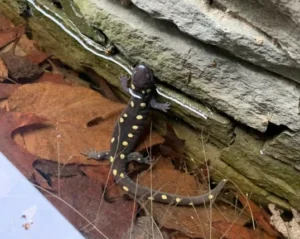Salamanders are amazing animals that live in forests, wetlands, and streams. They have moist skin that lets them absorb water and breathe in part through it. You might wonder what makes them special, and why people say salamanders are good signs of environmental health.
Salamanders are indicator species because their presence, how many there are, how healthy they look, and whether they are thriving can show the quality of their surroundings. Because they are very sensitive to pollution, changes in their environment, and even shifts in weather, they are a natural way to watch over ecosystems.
What Is an Indicator Species?
An indicator species is an animal or plant that shows how healthy an environment is.

These species react quickly when their environment changes or is under stress from things like pollution, habitat loss, or weather changes.
Scientists use them to:
- Assess ecosystem quality
- Detect early signs of environmental problems
- Guide conservation and management efforts
Since they respond fast, indicator species act like natural alarms that help protect all the other animals and plants around them.
3 Reasons Why Salamanders Are Excellent Indicator Species
Salamanders have traits that make them perfect for this role. Their skin is thin and lets water, oxygen, and chemicals pass through easily. This means they can quickly be affected by anything harmful in water or soil.
They also need clean, wet places to survive. Most species need water to lay eggs and land to live as adults. Any changes in water quality or habitat can affect them very quickly.
That’s why scientists notice problems in salamanders before many other animals show signs.
1. Sensitivity to Pollution and Contaminants
Salamanders’ skin exposes them directly to pollution. Pesticides, heavy metals, and chemicals in water can get into their bodies, causing illness or death.

Even small amounts can mess up their growth, reproduction, and immune system.
Water quality is very important since many salamanders breed in ponds, streams, or wetlands. Polluted breeding sites can reduce the chances that eggs hatch or that young salamanders survive.
By keeping track of salamanders, scientists can see how toxins affect the environment.
2. Response to Habitat Loss and Fragmentation
Salamanders need certain features in their environment, like moist soil, logs or leaf litter for cover, and clean water to breed.
When humans change the land through farming, building, or logging, these living spaces shrink.
Fragmentation can separate populations, making it harder for salamanders to move and mix genes.
Since salamanders can’t travel far easily, population drops or local extinctions can happen quickly when habitats are disturbed.
3. Impact of Climate Change on Salamanders
Climate change makes life harder for salamanders.
Changes in temperature and rainfall affect how wet their habitats stay. Droughts or floods can shrink safe areas for breeding and finding food.
Warmer weather may also change when salamanders breed or grow. Because they are used to stable conditions, sudden changes in climate can hurt their survival.
Watching salamander populations helps scientists see how the environment is being affected.
Monitoring Salamander Populations
Scientists check salamanders in many ways.
- Surveys mean looking for them in places they live, both day and night. Environmental DNA (eDNA) lets scientists find them by testing water without catching any animals.
- Health checks can measure body condition, parasites, or signs of disease.
Keeping track over a long time helps scientists see trends and decide how to protect salamanders and their homes.
Salamanders as Early Warning Signs
Salamanders are very sensitive, so changes in their numbers often show bigger problems are coming.
If salamander numbers drop, it could mean water pollution, habitat loss, or new diseases. These warnings let people act early to fix problems before they get worse.
Protecting salamanders also helps plants, animals, and humans living in the same area.
The Broader Ecological Importance of Salamanders
Salamanders are important in food webs, both as hunters and as prey. Their health shows not only environmental quality but also how other species are doing.
Keeping salamanders healthy supports biodiversity and helps ecosystems stay strong.
Watching them reminds us how life is connected and why it’s important to take care of natural places.
Conservation Implications
Recognizing salamanders as indicators shows why protecting their homes and keeping pollution low is important.
Efforts to save salamanders also help many other animals and plants. Protecting wetlands, forests, and clean water keeps ecosystems safe.
Teaching people about salamanders raises awareness about taking care of the environment.
How You Can Help Salamanders
People can contribute to salamander conservation by:
- Reducing pesticide and chemical use
- Supporting habitat restoration projects
- Reporting salamander sightings to citizen science programs
- Protecting local waterways and forests
- Avoiding disturbing salamanders and their habitats
Small actions help salamanders continue to show us how healthy ecosystems are.
Conclusion
Salamanders are important indicator species because they are very sensitive to environmental changes and need clean, wet habitats.
How many salamanders are around and how healthy they are gives us important information about pollution, habitat loss, and climate change.
Watching salamanders helps protect biodiversity and keep ecosystems balanced.
Hi, my name is Ezra Mushala, i have been interested animals all my life. I am the main author and editor here at snakeinformer.com.

